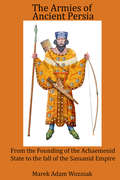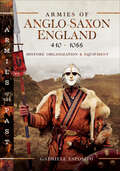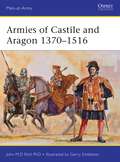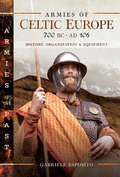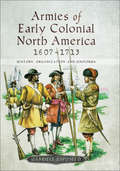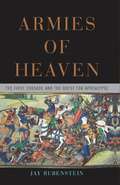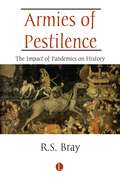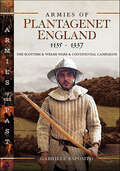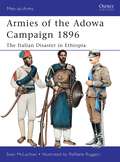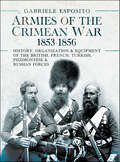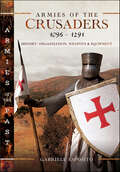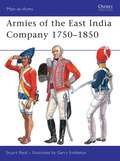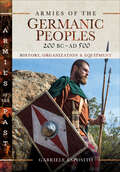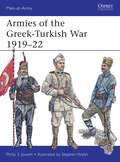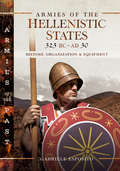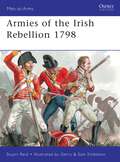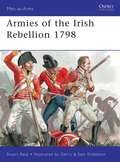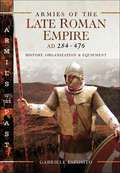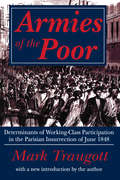- Table View
- List View
Armies of Ancient Italy, 753–218 BC: From the Foundation of Rome to the Start of the Second Punic War (Armies of the Past)
by Gabriele EspositoA military history of ancient Italy, featuring details of the weapons, equipment, and tactics, as well as color photos showing how warriors looked.Before becoming the masters of the Mediterranean world, the Romans had first to conquer the Italian peninsula in a series of harsh conflicts against its other varied and warlike residents. The outcome was no foregone conclusion and it took the Romans half a millennium to secure the whole of Italy.In Armies of Ancient Italy 753–218 BC, Gabriele Esposito presents the armies that fought these wars, in which the Roman military spirit and their famous legions were forged. He not only follows the evolution of the Roman forces from the Regal Period to the outbreak of the Second Punic War but also the forces of their neighbors, rivals and enemies. The most notable of these, the Etruscans, Samnites and the Italian Greeks are given particular attention but others, such as the Celts and Ligures of the North and the warriors of Sicily and Sardinia, are also considered. Details of the organization, weapons, equipment and tactics of each army are described, while dozens of beautiful color photos of reenactors show how these warriors looked in the field.“Once more, a beautifully illustrated book, this time starting with the story of Rome from the Regal Period to the Second Punic War. The author follows the highly successful format of his books covering the late period of the Roman Empire.—Most Highly Recommended.” —Firetrench“An interesting look at all the people of the Italian era, but what really brings it to life are the countless full colour photographs of re-enactor groups in the correct armour and dress for the various tribes and regions they represent. Excellent production standards and a fascinating look at the history of early Rome.” —The Armourer
Armies of Ancient Persia: From the Founding of the Achaemendid State to the Fall of the Sassanid Empire
by Marek Adam WozniakThe Armies of Ancient Persia is a translation of Marek Adam Wozniak’s original Polish manuscript detailing the rise and fall of the Persian armies from Cyrus the Great to the fall of the Sasanid Empire. Relying on a wealth of recent archeological evidence and studies, Dr. Wozniak provide a detail picture of the recruitment, organization, armament and battles of one of the largest armies of the ancient world
Armies of Anglo-Saxon England 410–1066: History, Organization and Equipment (Armies of the Past)
by Gabriele EspositoIn the early 5th century, Germanic Angles, Saxons and Jutes crossed the North Sea in increasing numbers and began settling among the ruins of the former Roman province of Britannia. This led to centuries of warfare as these 'Anglo-Saxons' carved new, independent kingdoms at the point of the sword, fighting the native Britons and each other. From the late eighth century they also had to face the threat of the Vikings, at first as opportunistic raiders but increasingly bent on conquest. The last Viking invasion was defeated by Harold Godwinson at Stamford Bridge but he was defeated by the Normans in that same fatal year of 1066, ending the Anglo-Saxon Age. Gabriele Esposito gives an overview of Anglo-Saxon military history, narrating the great campaigns, such as those of Alfred the Great of Wessex and Harold Godwinson. He discusses in detail the composition of Anglo-Saxon forces, their tactics, weapons and equipment, detailing developments across the period. The informative, accessible text is supported by dozens of color images showing replica Saxon war gear in use.
Armies of Castile and Aragon 1370-1516
by Gerry Embleton John PohlArmies of Castile and Aragon depicts the fighting men whose skill and tactical flexibility made Spain into a world power at the close of the Middle Ages, carving out empires from the Mediterranean to the Caribbean. Much has been written of the men who fought in the Hundred Years' War between England and France, and the Wars of the Roses. But meanwhile, on the Iberian peninsula, the foundations of Spain's military 'Golden Age' were being laid as the kingdoms of Castile and Aragon under the Trastamara dynasty grew in power, ambition and success. This book features spectacular full-color artwork, and rare manuscript illustrations.
Armies of Celtic Europe, 700 BC–AD 106: History, Organization & Equipment (Armies of the Past)
by Gabriele EspositoA look at the military might of these ancient warriors who sacked Rome and conquered much of Europe. Although comprised of many distinct tribes and groupings, the Celts shared a distinctive culture that dominated much of Europe for centuries, and enjoyed a formidable reputation as fierce and brave warriors, skilled horsemen, and fine metalworkers. In 390 BC, an alliance of Celtic tribes defeated a Roman army at the River Allia and went on to sack Rome and thenceforth the Romans lived under their threat. In the early third century BC, a Celtic army swept into Macedonia and Greece, won a major victory at Thermopylai, and ransacked the sacred sanctuary at Delphi. Such was their warlike prowess that, when not fighting their own wars, they were sought after as mercenaries by many armies, serving as far afield as southern Egypt. When the Romans invaded Gaul—modern-day France and Belgium—and the British Isles, Celtic armies resisted them fiercely. In this book, Gabriele Esposito studies this fascinating warrior culture, their armies, strategy, tactics, and equipment—they invented the horned saddle and chainmail, and British armies were the last in Europe to use chariots on the battlefield. Also included are dozens of color photographs of reenactors to help bring these magnificent warriors back to life.
Armies of Celtic Europe, 700 BC–AD 106: History, Organization & Equipment (Armies of the Past)
by Gabriele EspositoA look at the military might of these ancient warriors who sacked Rome and conquered much of Europe. Although comprised of many distinct tribes and groupings, the Celts shared a distinctive culture that dominated much of Europe for centuries, and enjoyed a formidable reputation as fierce and brave warriors, skilled horsemen, and fine metalworkers. In 390 BC, an alliance of Celtic tribes defeated a Roman army at the River Allia and went on to sack Rome and thenceforth the Romans lived under their threat. In the early third century BC, a Celtic army swept into Macedonia and Greece, won a major victory at Thermopylai, and ransacked the sacred sanctuary at Delphi. Such was their warlike prowess that, when not fighting their own wars, they were sought after as mercenaries by many armies, serving as far afield as southern Egypt. When the Romans invaded Gaul—modern-day France and Belgium—and the British Isles, Celtic armies resisted them fiercely. In this book, Gabriele Esposito studies this fascinating warrior culture, their armies, strategy, tactics, and equipment—they invented the horned saddle and chainmail, and British armies were the last in Europe to use chariots on the battlefield. Also included are dozens of color photographs of reenactors to help bring these magnificent warriors back to life.
Armies of Early Colonial North America, 1607–1713: History, Organization and Uniforms
by Gabriele EspositoGabriele Esposito presents a detailed overview of the military history of Colonial North America during its earliest period, from the first colonial settlement in Jamestown to the end of the first continental war fought in the Americas. He follows the development of organization and uniforms not only for the British Colonies of North America but also for the French ones of Canada. Every colonial unit formed by the Europeans in the New World, as well as the regular troops sent to America by Britain and France, is covered in detail: from the early militias of the Thirteen Colonies to the expeditionary forces formed during the War of the Spanish Succession. Great military events, like King Philips War or Bacons Rebellion, are analyzed and the evolution of tactics employed in this theater are discussed, showing how much warfare was influenced by the terrain and conditions in North America. Dozens of illustrations, including color art works, show the first military uniforms ever worn in North America, as well as interesting details of weaponry and equipment used.
Armies of Empire
by Allan ConverseThe study of military history forms a critical part of the Army's learning cycle. By publishing the work of the nation's pre-eminent military historians, the Australian Army and Cambridge University Press aim to promote, to a worldwide audience, our country's proud military heritage. Detailing the history of the Army, its people and its contribution to Australia's development, the series presents readers with contemporary perspectives and authoritative accounts of the key issues in the Army's past. The Australian Army is pleased to collaborate with Cambridge University Press to deliver the official Australian Army History Series. Book jacket.
Armies of Heaven: The First Crusade and the Quest for Apocalypse
by Jay RubensteinAt Moson, the river Danube ran red with blood. At Antioch, the Crusaders- their saddles freshly decorated with sawed-off heads-indiscriminately clogged the streets with the bodies of eastern Christians and Turks. At Ma'arra, they cooked children on spits and ate them. By the time the Crusaders reached Jerusalem, their quest-and their violence- had become distinctly otherworldly: blood literally ran shin-deep through the streets as the Crusaders overran the sacred city. Beginning in 1095 and culminating four bloody years later, the First Crusade represented a new kind of warfare: holy, unrestrained, and apocalyptic. In Armies of Heaven, medieval historian Jay Rubenstein tells the story of this cataclysmic event through the eyes of those who witnessed it, emphasizing the fundamental role that apocalyptic thought played in motivating the Crusaders. A thrilling work of military and religious history, Armies of Heaven will revolutionize our understanding of the Crusades.
Armies of Peace
by David Murray Susan E. Armstrong-ReidThe United Nations Relief and Rehabilitation Administration (UNRRA) was the first international organization to be established after the Second World War, and Canada played a key role in its formation. Formal studies of UNRRA, however, have tended to focus on inter-governmental political and economic relationships and their consequences for shaping the post-war international environment. Armies of Peace is the first comprehensive investigation of Canadians' influence on the establishment and operation of this unique organization. This volume challenges the hierarchical and policy-oriented approach to the study of international organizations and offers a more nuanced understanding of Canada's international involvement. By recounting the stories of hundreds of Canadians who served at every level of the organization and in every country where UNRRA established missions, Susan Armstrong-Reid and David Murray highlight the wider contributions that the nation made. Giving voice to these Canadians' stories also provides a more complete understanding of Canada's role in post-war healing and foreshadows the challenges that Canadians faced in implementing international aid and development initiatives within developing countries during the Cold War. Featuring previously untapped primary sources such as private papers, diaries, and letters, and utilizing a cross-disciplinary approach, Armies of Peace is an invaluable addition to the study of international organizations, Canadian social history, and the history of nursing.
Armies of Pestilence: The Impact of Disease on History
by Rs BrayWe have lived in a world that had, until the arrival in 2020 of the coronavirus Covid-19, not suffered a serious pandemic for a century, and society had almost forgotten the enormous impact created by highly infectious diseases. Infectious diseases, however, played major roles in ending the Golden Age of Athens, wrecked Justinian's plans to restore the Roman Empire to its former glory, and killed untold millions in Latin America after the Spanish invasion. Armies of Pestilence explores the impact of these diseases on history. Despite their importance, historians have tended to minimise the role of infectious disease - partly because of a lack of scientific knowledge, and this has resulted in a distorted view both of the past and of the danger of disease to modern society. In Armies of Pestilence, R.S. Bray, a distinguished biologist who here shows himself also to be an able historian, corrects this view. The book surveys the principal epidemics around the world and across the centuries, in each case discussing the origins of the outbreaks, the symptoms, the mortality rate and the social and economic effect. Where particular diseases cannot be identified with certainty the best scholarly opinions are discussed. Bray pays special attention to the infamous Yersina pestis, the organism that caused the Black Death. Other diseases discussed include malaria, smallpox, typhus, cholera and influenza, and AIDS. One of the themes of the book is the relationship between disease and war, with the former often causing more deaths than the latter, as was the case with the great influenza pandemic of 1918-19, at the end of the First World War. The inability of governments to deal effectively with disease is also made clear.
Armies of Plantagenet England, 1135–1337: The Scottish & Welsh Wars & Continental Campaigns (Armies Of The Past Ser.)
by Gabriele EspositoThe ascent of the Plantagenets to the English throne in 1154 led to the beginning of a new historical phase in the British Isles, which was marked by numerous wars that were fought between the Kingdom of England and the 'Celtic nations' of Wales, Scotland and Ireland. During the rule of the Norman kings, the English armies had not completed the conquest of Wales and had established only some footholds in Ireland; Scotland was still independent and was ready to contest the Plantagenets’ possession of northern England. As a result of this situation, the two centuries between the rise of the new dynasty and the beginning of the Hundred Years’ War were characterized by a series of wars that ravaged feudal England. Gabriele Esposito covers all these conflicts, following the campaigns of Richard the Lionheart as well as those of his younger brother who was defeated on the continent at the large Battle of Bouvines; the conquest of Wales is analyzed in detail, as well as the First Scottish War of Independence that saw William Wallace playing a prominent role. The organization and equipment of all the troop types taken into account is described in full detail and lavishly illustrated with color images of reenactors, bringing these forces to life.
Armies of the Adowa Campaign 1896
by Sean Mclachlan Raffaele RuggeriIn the late 19th century, the new nation-state of Italy was eager to join her European neighbors in creating an international empire. Italy's eyes turned towards Africa as a source of potential colonies. Most of the continent had already been carved up between the Great Powers but Italy succeeded in securing a foothold in Eritrea on the Red Sea coast, a vassal of the Emperor of Ethiopia. Trade and other links were established with the Ethiopian empire but quarrels regarding the interpretation of a particular clause led to Ethiopian support for uprisings in Eritrea. Italian troops entered northern Ethiopia and captured Adowa, the capital of the Tigray province. Full-scale war broke out and this new Osprey title tracks every development in the battle and the men who fought in it.From the Trade Paperback edition.
Armies of the Balkan Wars 1912-13: The Priming Charge for the Great War
by Philip S. JowettIn 1912, the Balkan states formed an alliance in an effort to break free from the crumbling Ottoman Empire. Forming an army of some 645,000 troops from Greece, Bulgaria, Serbia and Montenego, they took on a force of 400,000 Turkish soldiers. Both sides were equipped with the latest weapons technology. This book looks at the diverse and sometimes colorful uniforms worn by both sides, paying special attention to insignia, weapons and equipment. It also gives an overview of the campaign that became a "priming pan" of World War I.
Armies of the Crimean War, 1853–1856: History, Organization and Equipment of the British, French, Turkish, Piedmontese and Russian forces
by Gabriele EspositoLavishly illustrated with over 100 illustrations that detail the composition, organization, uniforms, weapons and equipment of each force. The Crimean War was the first major European war since the end of the Napoleonic Wars and Britain’s only war on that continent in the century between Waterloo and WW1. When Russia invaded provinces of the Ottoman Empire, the British and French, later joined by the Kingdom of Piedmont-Sardinia, intervened to limit Russian expansion towards the Black Sea. Each of the armies contained an eclectic mix of units. The regular European regiments still displayed much of the bright color and finery associated with the Napoleonic era (the British infantry in their scarlet tunics forming the famous ‘thin red line’ at Balaklava for instance), while each also contained a mix of exotic units drawn from across their respective empires. The French fielded Zouaves and Spahis from North and West Africa, not to mention the legendary Foreign Legion; the Ottomans had Tunisians and Egyptians alongside Balkan mountaineers and the infamous Bashi-bazouks; the Russians of course had their Cossacks and the British fielded little-known German, Swiss and Italian mercenaries. Gabriele Esposito details the composition, organization, uniforms and weaponry of each force and illustrates many of them with early black and white photos (this being the first major war for which photography was available), as well as numerous color artworks.
Armies of the Crusaders, 1096–1291: History, Organization, Weapons and Equipment
by Gabriele EspositoGabriele Esposito provides a detailed coverage of the elite Military Orders, whose members combined the fervor of a religious brotherhood with elite military professionalism. The Crusades were among the most astonishing historical events that took place during the Middle Ages. After centuries of relative isolation following the fall of the Roman Empire, Western Europe looked again towards the Middle East in search of lands to conquer. Incited by the Church to believe that the Holy Land must be ‘liberated’ from its Muslim rulers (who had by then occupied it for centuries), and that to do so would bring spiritual salvation, many thousands from all over Christian Europe ‘took the cross’ and joined the Crusades. Led by some of the most illustrious personalities of the age, such as Richard the Lionheart and Frederick Barbarossa, they fought numerous campaigns and even founded new ‘Crusader states’, some of which lasted for almost two centuries. Gabriele Esposito gives an overview of the key events of these campaigns, from the First Crusade in 1096 to the fall of Acre, the last Christian stronghold in the Holy Land, in 1291. He analyzes the various contingents that made up the Crusader forces, describing their equipment and tactics and showing how they attempted to adapt to unfamiliar terrain and enemies. Included, of course, are the military orders (the Templar, Hospitaller and Teutonic knights) who combined the religious fervour of a monastic brotherhood with martial prowess, forming an elite core to the Christian forces. As usual, the informative text is lavishly illustrated with color photos depicting replica weapons and equipment in use.
Armies of the East India Company 1750-1850
by Gerry Embleton Stuart ReidContrary to popular belief, the capture of India was not accomplished by the British Army, but by the private armies of the East India Company, whose primary objective was the protection of their trading empire. Under the leadership of the legendary Robert Clive (founder of the East India Company) and Stringer Lawrence, this small force of mercenaries and adventurers grew in size and strength to eventually become an army larger than that of any European sovereign state. Highly disciplined and professional, it fought almost continuously for a century until the Great Mutiny of 1857 led to its disbandment and its troops passed into Crown service. One of the many British Army officers who fought with this force was Arthur Wellesley, the future Duke of Wellington. This is the fascinating history of the East India Company army, examining the many conflicts in which they fought, and their equipment and training, with its regiments of horse, foot and guns, which rivalled those of most European powers. The exotic uniforms combining traditional Indian and British dress are illustrated in detail and make for a wonderfully colorful account of a private band of adventurers that successfully captured the jewel of the British Empire.
Armies of the Germanic Peoples, 200 BC–AD 500: History, Organization & Equipment
by Gabriele EspositoGabriele Esposito presents an overview of the military history of the Germanic peoples of this period and describes in detail the weapons and tactics they employed on the battlefield. He starts by showing how, from very early on, the Germanic communities were heavily influenced by Celtic culture. He then moves on to describe the major military events, starting with the first major encounter between the Germanic tribes and the Romans: the invasion by the Cimbri and Teutones. Julius Caesar's campaigns against German groups seeking to enter Gaul are described in detail as is the pivotal Battle of the Teutoburg Forest, which effectively halted Roman expansion into Germany and for centuries fixed the Rhine as the border between the Roman and Germanic civilizations. Escalating pressure of Germanic raids and invasions was a major factor in the collapse of the Western Roman Empire. The author's analysis explains how Germanic warriors were able to crush the Roman military forces on several occasions, gradually transformed the Roman Army itself from the inside and, after the fall of the Empire, created new Romano-Germanic Kingdoms across Europe. The evolution of Germanic weapons, equipment and tactics is examined and brought to life through dozens of color photos of replica equipment in use.
Armies of the Greek-Turkish War 1919-22
by Philip JowettThis is a comprehensive guide to the armies that fought a devastating and decisive conflict in the Eastern Mediterranean between the two World Wars of the 20th century. From the initial Greek invasion, designed to "liberate" the 100,000 ethnic Greeks that lived in Western Turkey and had done for centuries, to Mustapha Kemal Ataturk's incredibly efficient formation of a national government and a regular army, this was a war that shaped the geopolitical landscape of the Mediterranean to this day. It gave birth to the modern Turkish state, displacing millions and creating bitter memories of atrocities committed by both sides. Augmented with very rare photographs and beautiful illustrations, this ground-breaking title explores the history, organization, and appearance of the armies, both guerilla and conventional, that fought in this bloody war.
Armies of the Hellenistic States, 323 BC–AD 30: History, Organization & Equipment
by Gabriele EspositoThis fully illustrated history chronicles the evolution of Hellenistic warfare from the death of Alexander the Great to Rome&’s conquest of the region. This book provides a complete and detailed analysis of the organization and equipment employed by the armies of the Hellenistic States. After Alexander the Great&’s death in 323 BC, his immense Macedonian empire was divided between his generals, who in turn formed their own monarchies across Eastern Europe, Asia and North Africa. This work will follow the development of the Hellenistic military forces from the army bequeathed by Alexander to the complex military machines that succumbed one by one in the wars against the expanding Romans. Fully illustrated with color photographs, this volume also shows how Hellenistic forces were strongly influenced by Roman models during the last years of independence of their kingdoms. The states analyzed are: Macedon, Seleucid Empire, Ptolemaic Egypt, The Greco-Bactrian Kingdom, Armenia, Pergamon, Pontus, Cappadocia, Galatia, The Bosporan Kingdom, Epirus, Sicily, The Achaean League and The Aetolian League.
Armies of the Irish Rebellion 1798
by Gerry Embleton Stuart ReidA stunning exploration of a legendary moment in Irish history. In 1798 with the British Army preoccupied in fighting France in the Caribbean and Mediterranean as well as guarding Southeast England from threatened invasion, a co-ordinated uprising broke out across the water in Ireland. Uniquely this was neither a Catholic nor a Protestant rebellion, but rather a joint effort by leaders and insurgents from both sides of the community. The Irish Rebellion (1798) was directed against the corrupt government based at Dublin Castle and was inspired in part by the people's revolutions in America and France. This title illuminates the lives of the Irish peasants, armed mostly with pikes, who confronted the small number of British troops based in their country.From the Trade Paperback edition.
Armies of the Irish Rebellion 1798
by Stuart ReidA stunning exploration of a legendary moment in Irish history. In 1798 with the British Army preoccupied in fighting France in the Caribbean and Mediterranean as well as guarding Southeast England from threatened invasion, a co-ordinated uprising broke out across the water in Ireland. Uniquely this was neither a Catholic nor a Protestant rebellion, but rather a joint effort by leaders and insurgents from both sides of the community. The Irish Rebellion (1798) was directed against the corrupt government based at Dublin Castle and was inspired in part by the people's revolutions in America and France. This title illuminates the lives of the Irish peasants, armed mostly with pikes, who confronted the small number of British troops based in their country. From the Trade Paperback edition.
Armies of the Late Roman Empire, AD 284–476: History, Organization & Equipment (Armies Of The Past Ser.)
by Gabriele EspositoAn illustrated guide to the organization, structure, equipment, weapons, combat history, and tactics of the Late Roman military forces.This guide to the Late Roman Army focusses on the dramatic and crucial period that started with the accession of Diocletian and ended with the definitive fall of the Western Roman Empire. This was a turbulent period during which the Roman state and its armed forces changed.Gabriele Esposito challenges many stereotypes and misconceptions regarding the Late Roman Army; for example, he argues that the Roman military machine remained a reliable and efficient one until the very last decades of the Western Empire. The author describes the organization, structure, equipment, weapons, combat history and tactics of Late Roman military forces. The comitatenses (field armies), limitanei (frontier units), foederati (allied soldiers), bucellarii (mercenaries), scholae palatinae (mounted bodyguards), protectores (personal guards) and many other kinds of troops are covered.The book is lavishly illustrated in color, including the shield devices from the Notitia Dignitatum. The origins and causes for the final military fall of the Empire are discussed in detail, as well as the influence of the “barbarian” peoples on the Roman Army.Praise for Armies of the Late Roman Empire, AD 284–476“An excellent introduction to the subject for the novice, and seasoned students of the subject may find it of use as well.” —The NYMAS Review“This beautifully illustrated book depicts the very different arms and armour of the late Roman Empire as Roman soldiers adapted to the challenges of the rising barbarian armies . . . Very Highly Recommended.” —Firetrench“Superbly well-illustrated . . . historians, re-enactors and war gamers will find invaluable to understanding and picturing the Roman forces.” —Hoplite Association
Armies of the Napoleonic Wars
by Gregory Fremont-BarnesThe armies of the Napoleonic Wars fought in a series of devastating campaigns that disturbed the peace of Europe for twelve years, yet the composition, organization and fighting efficiency of these forces receive too little attention. Each force tends to be examined in isolation or in the context of an individual battle or campaign or as the instrument of a famous commander. Rarely have these armies been studied together in a single volume as they are in this authoritative and fascinating reassessment edited by Gregory Fremont-Barnes.Leading experts on the Napoleonic Wars have been specially commissioned to produce chapters on each of the armed forces that took part in this momentous era in European history. The result is a vivid comparative portrait of ten of the most significant armies of the period, and of military service and warfare in the early nineteenth century. The book will be essential reading and reference for all students of the Napoleonic era.Covers the armies of Austria, Britain, the Confederation of the Rhine, the Duchy of Warsaw, France, the Kingdom of Italy, Portugal, Prussia, Russia and Spain.
Armies of the Poor: Determinants of Working-class Participation in in the Parisian Insurrection of June 1848
by Mark TraugottIn June 1848, two irregular armies of the urban poor fought a four-day battle in the streets of Paris that decided the fate of the French Second Republic. The Parisian National Workshops and the Parisian Mobile Guard-organizations newly created at the time of the February Revolution-provided the bulk of the June combatants associated with the insurrection and repression, respectively. According to Marx's simple and compelling hypothesis, a nascent French proletariat unsuccessfully attempted to assert its political and social rights against a coalition of the bourgeoisie and lumpenproletariat, represented by the Parisian Mobile Guard. Through a detailed study of archival sources, Mark Traugott challenges this interpretation of these events and proposes an organizational explanation.Research has consistently shown that skilled artisans and not unskilled proletarians stood at the forefront of the revolutionary struggles of the nineteenth century. Traugott compares the social identities of the main participants on opposite sides of the conflict and sorts out the reasons for the political alignments observed. Drawing on work by Charles Tilly and Lynn Lees, Traugott demonstrates that the insurgents were not highly proletarianized workers, but rather members of the highly skilled trades predominant in the Parisian economy. Meanwhile, those who spearheaded the repression were little different in occupational status, though they tended to be significantly younger. Traugott's ""organizational hypothesis"" makes sense of the observed configuration of forces. He accounts for the age differential as a by-product of the recruitment criteria that Mobile Guard volunteers were required to meet. Finally, he explains why class position creates no more than a diffuse political predisposition that remains subject to the influence of situation-specific factors such as organizational affiliations. Armies of the Poor helps clarify our understanding of the dynamic at work in the insurrectiona

